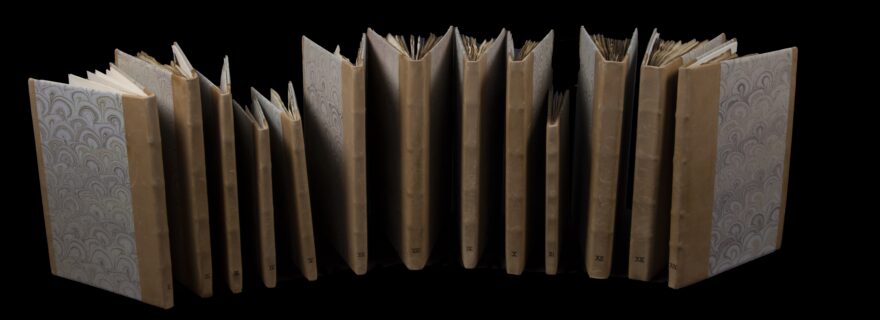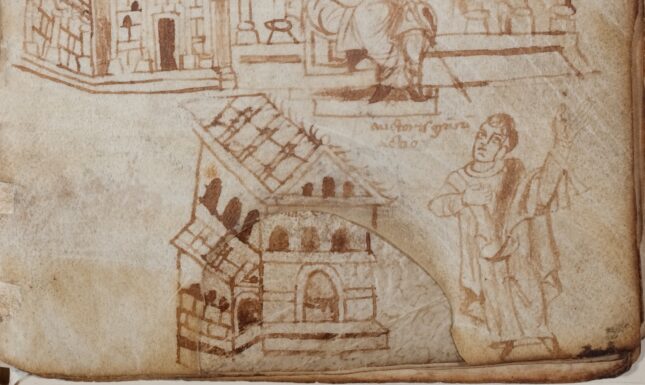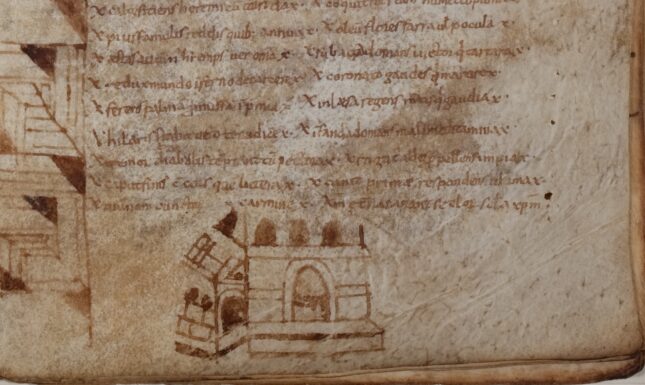Ademar of Chabannes's notebooks: A glimpse into the working methods of a medieval scholar
A recent study afternoon held at the University Libraries, Leiden, introduced scholars and members of the public to one of the most unique manuscripts in our collection – VLO 15, the notebooks of Ademar of Chabannes.
There are some manuscripts held at Leiden’s University Libraries that have an enigmatic quality; they seem to be more than the words they contain, more than the materials upon which they are written. One such manuscript is Leiden, Universiteitsbibliotheek, Vossius Latinus Octavo 15 (hence VLO 15). VLO 15 now comprises fourteen separately bound booklets written in the hand of Ademar of Chabannes (989-1034), a monk, compiler, author, teacher and historian.
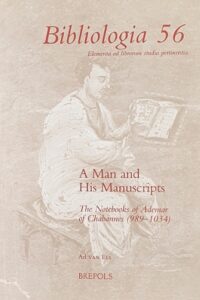
On 12 October, 2022, a study afternoon was held at Leiden University Libraries (UB) to discuss aspects of Ademar’s work and introduce VLO 15 and its scribe to a public audience. The occasion of the study afternoon was the formal launch of a monograph of Dr Ad van Els entitled A man and his manuscripts: The notebooks of Ademar of Chabannes (989-1034) (Brepols: Turnhout, 2020). As this volume was published during the period of Covid-19 restrictions, opportunities to present its findings to a broader public had thus far been limited. The study afternoon resolved this shortfall through a series of short papers focusing on Ademar’s work (through the lens of Van Els’s research). This study afternoon culminated in a pop-up exhibition, a rare chance to see Ademar’s booklets on display.
The study afternoon opened with an introduction by the curator of Western Medieval Manuscripts at Leiden UB, André Bouwman, who described how Ademar’s notebooks came to Leiden. Acquired as part of the collection of Isaac Vossius in 1690, its parts were, as Bouwman recounted, originally bound in a single volume, ‘almost as fat as it was high’. The original binding, by then damaged, was removed in 1875. At that point the manuscript was broken into its present fourteen parts, an arrangement that reflected Ademar’s original practices. Of varied lengths, these booklets were his notebooks, where he collected material, such as extracts from texts, drawings, recipes, charters, and hymns.
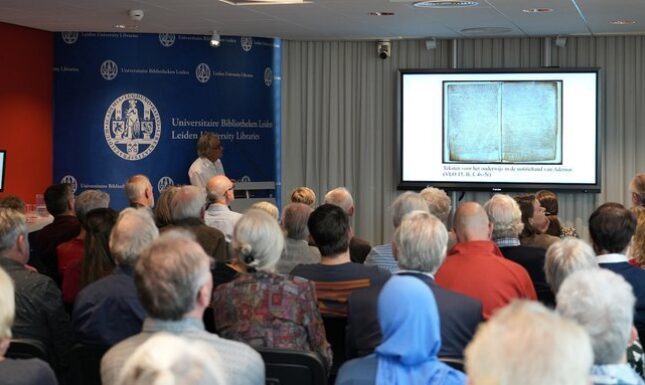
In his paper, ‘Het beeld van Ademar in de geschiedschrijving: feit en fictie’ [The image of Ademar in history writing: fact and fiction] Ad van Els not only assessed perspectives of contemporary scholars on Ademar’s life, but also contextualised Ademar’s notebooks in the light of his other scribal products. Ademar was a prolific scribe, and Van Els placed particular emphasis on how active he was in promoting the cult of Saint Martial, the patron of the monastery in Limoges. Van Els brought moments of Ademar’s career to life - such as a brief note written by Ademar concerning his observations of a solar eclipse (Biblioteca Apostolica Vaticana, MS Reg. lat. 1332, f. 43v) or the memorable self-portrait of the scribe found in the corner of an illustrated initial of Saint Eparchius, which catches the reader’s eye in Paris, Bibliothèque nationale de France, MS lat. 3784, f. 99v.
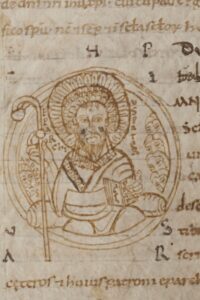

Such an approach, which treats palaeographical (the study of script), codicological (the study of the physical features of a book) and historical evidence in conjunction is typical of Van Els’s research method, as Jan Burgers, the second speaker, commented. Burgers who spoke on Ademar’s script (‘De hand van Ademar. Over het herkennen van middeleeuwse scribenten’ [The hand of Ademar. On the identification of medieval scribes]), noted that the identification of medieval scribes is notoriously challenging. A scribe is, as Burgers commented, a person, not a robot, and will, therefore, inevitably change their way of writing over their lifetime. As Burgers described, Van Els analysed every letter form used by Ademar in detail, thus building up a body of valuable observations regarding this scholar's individual scribal practice. Through such methods, Van Els also observed other traits of Ademar-at-work: for example, he did not always separate the words of his texts consistently and tended to stray from the marked lines of the page.
The two final papers, delivered by Mariken Teeuwen (‘Het boek van de meester: profiel van een werkhandschrift’ [The work of a master: A profile of a working-manuscript] and Marco Mostert [‘Was Ademar uniek? Over sporen van schoolmeesters in handschriften uit de eerste helft van de elfde eeuw’ [Was Ademar unique? Traces of schoolmasters in manuscripts from the first half of the eleventh century], both sought to contextualise Ademar in the intellectual climate of his day. As Teeuwen observed, within the margins and interlinear space of medieval manuscripts we often find notes of scholars. Ademar’s work of text-collection, excerption and imaginative reworkings can be situated within the context of such broader pedagogical tendencies. Mostert, meanwhile, illustrated how medieval scholars played with texts, exchanging (sometimes obscure) knowledge on the pages of their manuscripts. He noted that in spite of the fact that no students can be firmly associated with Ademar-the-teacher, his works were carefully preserved; on f. 141v of VLO 15, Ademar is described by a later writer as a ‘grammarian of fond memory’.
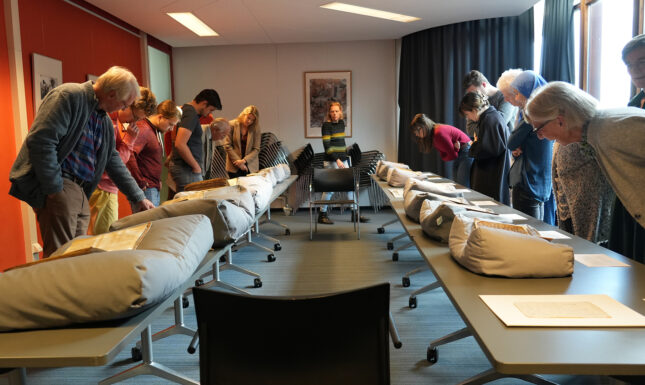

An image arose from these papers of Ademar as a character with diverse strengths, working within a contemporary intellectual climate where texts and ideas were exchanged in often lively ways. The afternoon concluded with a chance to see the booklets of Leiden UB, VLO 15 themselves. The presentation, facilitated by the conservation department of Leiden University Libraries, enabled the viewer to see the fourteen fascicules together, each open at a particular page. Given their rarity, these booklets are rarely displayed. Using a pop-up exhibition format, where manuscripts are displayed only for a limited time in a controlled setting, enables unusual treasures like these booklets to be accessed by scholars and public alike.
As you can see in the first image, Ademar drew this building on VLO 15, f. 43r around a curvature at the edge of a parchment sheet. In the second image, you can see how Ademar drew the remainder of the building on the subsequent leaf (VLO 15, f. 44r). Here he grapples with the limits of his medium, while simultaneously exploiting its qualities to add dimensionality to his drawing.
On account of my own research interests, I had had the opportunity to examine individual booklets of VLO 15 in the Special Collections reading room of Leiden Library on a previous occasion, but had never seen all of them simultaneously on display. Following on from the informative series of encounters we had had with Ademar through the words of various scholars throughout the afternoon, I was struck anew by the emotional experience of seeing Ademar’s own hand at work. The booklets, comprised of parchment of varied sizes and of frequently poor quality, were written by Ademar at various stages. In spite of their humble format, of perhaps because of this, they have an animate, almost spontaneous quality. Through their pages, we can appraise Ademar’s interests, preoccupations, and abilities, and evaluate a medieval-scholar-in-action.
Ad van Els's study of Ademar is available for purchase here. You can virtually browse all parts of VLO 15 here. I would like to thank Dr André Bouwman for providing photographs for this post.
© Irene O'Daly and Leiden Medievalists Blog, 2022. Unauthorised use and/or duplication of this material without express and written permission from this site’s author and/or owner is strictly prohibited. Excerpts and links may be used, provided that full and clear credit is given to Irene O'Daly and Leiden Medievalists Blog with appropriate and specific direction to the original content.


